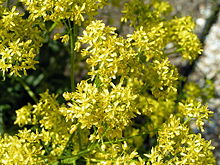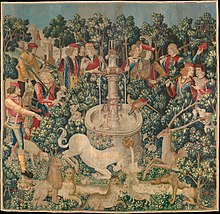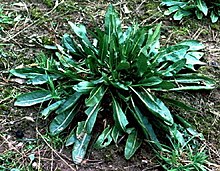Isatis tinctoria: Difference between revisions
grammar |
|||
| Line 18: | Line 18: | ||
|}} |
|}} |
||
'''''Isatis tinctoria''''', with ''' |
'''''Isatis tinctoria''''', with '''woad''' ({{IPAc-en|ˈ|w|oʊ|d}}) or '''glastum''' as the common name, is a [[flowering plant]] in the family [[Brassicaceae]]. It is commonly called dyer's woad. It is occasionally known as Asp of Jerusalem. Woad is also the name of a [[blue]] [[dye]] produced from the leaves<ref> |
||
{{cite web |
{{cite web |
||
| url = http://www.merriam-webster.com/dictionary/woad |
| url = http://www.merriam-webster.com/dictionary/woad |
||
Revision as of 16:56, 8 November 2013
| Isatis tinctoria Woad | |
|---|---|

| |
| Woad flowers | |
| Scientific classification | |
| Kingdom: | |
| (unranked): | |
| (unranked): | |
| (unranked): | |
| Order: | |
| Family: | |
| Genus: | |
| Species: | I. tinctoria
|
| Binomial name | |
| Isatis tinctoria | |
| Synonyms | |
|
Isatis indigotica Fortune | |
Isatis tinctoria, with woad (/ˈwoʊd/) or glastum as the common name, is a flowering plant in the family Brassicaceae. It is commonly called dyer's woad. It is occasionally known as Asp of Jerusalem. Woad is also the name of a blue dye produced from the leaves[2] of the plant.
Woad is native to the steppe and desert zones of the Caucasus, Central Asia to eastern Siberia and Western Asia (Hegi), but is now found in southeastern and some parts of Central Europe as well. Long important as a source of blue dye, it has been cultivated throughout Europe, especially in Western and southern Europe, since ancient times. In medieval times there were important woad growing regions in England, Germany and France, and towns such as Toulouse became prosperous on the woad trade. Woad was eventually replaced by the stronger indigo and then by synthetic indigoes.
History of woad cultivation
Ancient use
The first archaeological finds of woad seeds date to the Neolithic and have been found in the French cave of l'Audoste, Bouches-du-Rhône (France). Named Färberwaid (Isatis tinctoria L.) or German Indigo, of the plant family (Brassicaceae), in the Iron Age settlement of the Heuneburg, Germany, impressions of the seeds have been found on pottery. The Hallstatt burials of Hochdorf[disambiguation needed] and Hohmichele contained textiles dyed with Färberwaid (woad dye).


Melo and Rondão write that woad was known "as far back as the time of the ancient Egyptians, who used it to dye the cloth wrappings applied for the mummies."[3] Skelton informs us that one of the early dyes discovered by the ancient Egyptians was "blue woad (Isatis tinctoria)."[4] Lucas writes, "What has been assumed to have been Indian Indigo on ancient Egyptian fabrics may have been woad."[5] Hall states that the ancient Egyptians created their blue dye "by using indigotin, otherwise known as woad."[6]
Julius Caesar tells us (in De Bello Gallico) that the Britanni used to colour their bodies blue with vitrum, a word that roughly translates to "glass". Many have assumed that vitrum refers to woad, but other modern authors regard this as a misconception, possibly repeated for political reasons; Caesar may also have described some form of copper- or iron-based pigment.[7][unreliable source?] The northern inhabitants of Britain came to be known as Picts (Picti), which means "painted ones" in Latin, and may have been due to these accounts of them painting or tattooing their bodies.
The medieval period onwards

Woad was one of the three staples of the European dyeing industry, along with weld (yellow) and madder (red).[8] Chaucer mentions their use by the dyer ("litestere") in his poem The Former Age, among other cultural inventions that were previously absent:[9]
- No mader, welde, or wood no litestere.
- Ne knew; the flees was of his former hewe
The three can be seen together in tapestries such as The Hunt of the Unicorn (1495–1505), though typically it is the dark blue of the woad that has lasted best.
In Viking age levels at York, a dye shop with remains of both woad and madder dating from the 10th century have been excavated. In Medieval times, centres of woad–cultivation lay in Lincolnshire and Somerset in England, Jülich and the Erfurt area in Thuringia in Germany, Piedmont and Tuscany in Italy, and Gascogne, Normandy, the Somme Basin (from Amiens to Saint-Quentin), Britany and above all Languedoc in France. This last region, in the triangle between Toulouse, Albi and Carcassonne, was for long the most productive of woad, or "pastel" as it was known there, one writer commenting that "woad... hath made that country the happiest and richest in Europe."[8] The prosperous woad merchants of Toulouse displayed their affluence in splendid mansions, many of which are still standing. One, Jean de Bernuy, a Spanish Jew who had fled the inquisition, was credit-worthy enough to be the main guarantor of the ransomed King Francis I after his capture at the Battle of Pavia by Charles V of Spain.[8] Much of the woad produced here was used for the cloth industry in southern France,[10] but it was also exported via Bayonne, Narbonne and Bordeaux to Flanders, the Low Countries, Italy, and above all Britain and Spain.
A major market for woad was at Görlitz in Silesia.[11] The citizens of the five Thuringian Färberwaid (dye woad) towns of Erfurt, Gotha, Tennstedt, Arnstadt and Langensalza had their own charters. In Erfurt, the woad-traders gave the funds to found the University of Erfurt. Traditional fabric is still printed with woad in Thuringia, Saxony and Lusatia today: it is known as Blaudruck (literally, "blue print(ing)").
Medieval uses of the dye were not limited to textiles. For example, the illustrator of the Lindisfarne Gospels used a woad-based pigment for blue paint.
Woad and indigo

The dye chemical extracted from woad is indigo, the same dye extracted from "true indigo", Indigofera tinctoria, but in a lower concentration. With the European discovery of the seaway to India, great amounts of indigo were imported. Laws were passed in some parts of Europe to protect the woad industry from the competition of the indigo trade. Indigo was proclaimed to rot the yarns as well. "In 1577 the German government officially prohibited the use of indigo, denouncing it as that pernicious, deceitful and corrosive substance, the Devil's dye."[12] "... a recess of the Diet held in 1577 prohibited the use of 'the newly-invented, deceitful, eating and corrosive dye called the devil's dye.'" This prohibition was repeated in 1594 and again in 1603.[13] In France, Henry IV, in an edict of 1609, forbade under pain of death the use of "the false and pernicious Indian drug".[14]
With the development of a chemical process to synthesize the pigment, both the woad and natural indigo industries collapsed in the first years of the 20th century. The last commercial harvest of woad until recent times occurred in 1932, in Lincolnshire, Britain. Small amounts of woad are now grown in UK and France to supply craft dyers.[15] The classic book about woad is The Woad Plant and its Dye by J. B. Hurry, Oxford University Press of 1930, which contains an extensive bibliography.[16]
A method for producing indigo dye from woad is described in the book The History of Woad and the Medieval Woad Vat (1998) ISBN 0-9534133-0-6.[17]
In Germany, there are attempts to use woad to protect wood against decay without dangerous chemicals. Production is also increasing again in the UK for use in inks, particularly for inkjet printers, and dyes, as woad is biodegradable and safe in the environment, unlike many synthetic inks. The plant's presence has its problem however since Isatis tinctoria is viewed as an invasive species in parts of the United States.
Woad and health
This section needs more reliable medical references for verification or relies too heavily on primary sources. (July 2012) |  |
Chemicals from woad might be used to prevent cancer, as it can produce high levels of glucobrassicin.[18][19] Young leaves when damaged can produce more glucobrassicin, up to 65 times as much.[20]
Indigowoad Root (Chinese: 板藍根; pinyin: bǎn lán gēn) is a traditional Chinese medicine herb that comes from the roots of woad. Literature on traditional Chinese medicine uses the scientific name Isatis indigotica, although this name is usually considered synonymous with Isatis tinctoria by botanists. It is also known as Radix isatidis. The herb is cultivated in various regions of northern China, namely Hebei, Beijing, Heilongjiang, Henan, Jiangsu, and Gansu. The roots are harvested during the autumn and dried. The dried root is then processed into granules, which are most commonly consumed dissolved in hot water or tea. The product is very popular throughout China. Possible minor side effects include allergic reactions and dizziness; only large dosages or long term usage can be toxic to the kidneys. Treatments have not generally been evaluated clinically.[citation needed]
Invasive and noxious weed
In certain locations the plant is classified as a non-native and invasive weed. It is listed as a noxious weed by the agriculture departments of several states in the western United States.[21][22] In Montana, it has been the target of an extensive, and largely successful, eradication attempt.[23]
References
- ^ www.t75.org. "King Arthur - Key historical facts". Indielondon.co.uk. Retrieved 2012-10-09.
{{cite web}}: CS1 maint: numeric names: authors list (link) - ^ "Woad – Definition and More". Merriam Webster. Retrieved 3 February 2011.
- ^ Spectral and Photophysical Studies of Substituted Indigo Derivatives in Their Keto Forms J. Sérgio Seixas de Melo Dr., Raquel Rondão, Hugh D. Burrows Prof. Dr., Maria J. Melo Dr., Suppiah Navaratnam Dr., Ruth Edge Dr., Gundula Voss Dr., ChemPhysChem, Volume 7, Issue 11, pages 2303–2311, November 13, 2006
- ^ Skelton, H., A Colour Chemist’s History of Western Art, – Review of Progress in Coloration and Related, 1999
- ^ A. Lucas,Ancient Egyptian Materials and Industries
- ^ Hall,Rosalind, Egyptian Textiles,(Shire Egyptology, pg. 10
- ^ "The Problem of the Woad". Dunsgathan.net. Retrieved 2012-10-09. However, archaeological finds prove the existence and use of woad in iron-age Britain: M. Van der Veen/A.R. Hall/J. May, Woad and the Britons Painted Blue, Oxford Journal of Archaeology 12.3 (1993) 367—371
- ^ a b c Balfour-Paul, Jenny (2006). Indigo. London: Archetype Publications. ISBN 978-1-904982-15-9. Cite error: The named reference "indigo" was defined multiple times with different content (see the help page).
- ^ The Former Age at bartleby.com
- ^ Pauls, Michael (2007). Gascony & the pyrenees (5th ed. ed.). London: Cadogan Guides. p. 314. ISBN 978-1-86011-360-4.
{{cite book}}:|edition=has extra text (help); Unknown parameter|coauthors=ignored (|author=suggested) (help) - ^ Werner Sombart, Der Moderne Kapitalismus (15ty ed.) 1928, vol I, p. 231.
- ^ Lippincott's Magazine of Popular Literature and Science, Volume 17, No. 100, April, 1876.
- ^ D G Schreber, Historische, physische und economische Beschreibung des Waidtes, 1752, the appendix; Thorpe JF and Ingold CK, 1923, Synthetic colouring matters - vat colours (London: Longmans, Green), p. 23
- ^ Frost, John (1846). The book of illustrious mechanics of Europe and America. p. 236. Retrieved 7 May 2011.
{{cite book}}: External link in|coauthors=|coauthors=ignored (|author=suggested) (help) - ^ Chris Cooksey. "Indigo - woad". Chriscooksey.demon.co.uk. Retrieved 2012-10-09.
- ^ "J B Hurry's woad bibliography". Chriscooksey.demon.co.uk. Retrieved 2012-10-09.
- ^ "Historic Dyes Series No. 1 - The History of Woad and the Medieval Woad Vat by John Edmonds". unknown. Retrieved 28 January 2011.
- ^ Galletti, Stefania; Barillari, Jessica; Iori, Renato; Venturi, Gianpietro (14 August 2006). "Glucobrassicin enhancement in woad (Isatis tinctoria) leaves by chemical and physical treatments". Journal of the Science of Food and Agriculture. 86 (12). Wiley: 1833–1836. doi:10.1002/jsfa.2571.
- ^ "War paint plant 'tackles cancer'". BBC online, 13 August 2006. Accessed 2007-06-02
- ^ "Celts' warpaint may be weapon to beat cancer". The Telegraph,14 August 2006. Accessed 2007-06-02
- ^ "PLANTS Profile for Isatis tinctoria (Dyer's woad)". Retrieved November 24, 2009.
- ^ "Prohibited, Regulated and Restricted Noxious Weeds". Retrieved November 24, 2009.
- ^ Monica L. Pokorny and Jane M. Krueger-Mangold. "Evaluating Montana's Dyer's Woad (Isatis tinctoria) Cooperative Eradication Project" (PDF). Weed Technology 2007 21:262–269.
24. Kaiser-Alexnat, Renate: Wonder Woad. Experiences involving human and plant – especially woad – reported in pictures and stories. epubli GmbH Berlin, ISBN 978-3-8442-5227-9, 72 pages, 2013. description and preview
External links
- Woad.org.uk - All About Woad - Cultivation, Extraction, Dyeing with Woad, History and facts about woad
- Balfour-Paul, Jenny (1998) Indigo. London, British Museum
- The Former Woad Industry
- From woad warriors to cancer-buster - Woad anticancer properties, New Scientist.
- IndigoPage.com: Information, discussion, pictures on artistic uses of indigo dye.
- The preparation of Woad - excerpt from paper by H. O. Clarke and Rex Wailes in Transactions of the Newcomen Society, 1935-36 Vol 16.
- The Problem of the Woad - Use of Woad in Body Art
- USDA information on Isatis tinctoria
- Woad is me: botany page at UCLA
- Data sheet with pictures of woad (in German)
- Wonder Woad - Stories with quintessences on the meaning of the woad

